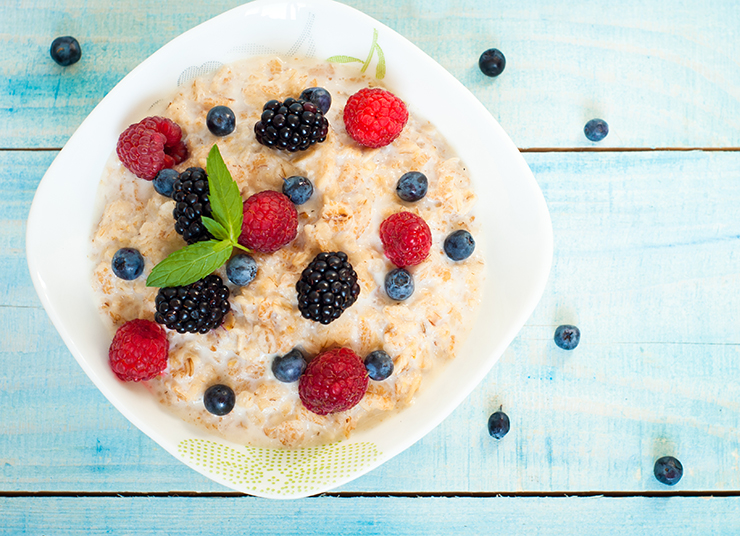Here’s the final instalment in our series on fixing the holes in your diet
By Wendy Haaf
Photo: iStock/Solovyova.

Photo: Dreamstime/Sonic770.
Many Canadians seem to be falling short when it comes to whole-grain intake. Canada’s Food Guide recommends that at least half of our recommended six to eight daily servings of grain products comes from whole grains, but according to a 2010 survey of 1,000 adults conducted for Dempster’s foods, only 4 per cent of respondents aged 55 to 64 managed to consume that much. (One serving is roughly equivalent to a half-cup, or 125 mL, of rice or a small slice of bread.) Increasing your consumption of whole grains is a good way to boost your fibre intake, since this nutrient is removed from refined grains.
Here are some ideas to help you get more whole grain into your diet.
Dish up oatmeal.

Photo: iStock/Nadianb.
Quick-cooking rolled oats can be prepared in under two minutes in the microwave: top with frozen berries, stir in a handful of nuts or peanut butter and a tablespoon of ground flaxseed, and you’ve managed a serving each of whole grains, protein, dairy, and fruit.
Or for a no-cook treat, take a mason jar or other container and stir in a quarter-cup of oats, a quarter-cup of plain yogourt, a quarter-cup of fresh or frozen fruit, a tablespoon (15 mL) of ground flax, a quarter- to a half-cup of milk, and a drizzle of sweetener. Leave in the refrigerator overnight; in the morning, sprinkle with almonds or walnuts and enjoy.
You can cook up a pot of oatmeal and freeze measured portions in a muffin tin lined with plastic wrap and warm up as needed. “Some people find that helps with portion control,” says Vincci Tsui, a registered dietitian in Calgary.
Give whole-grain pasta a go.
If you find the firm texture of whole wheat noodles off-putting, try cooking the angel hair variety or spaghettini for just a little longer than stated in the package directions, says Kathy Hester, a Durham, North Carolina, food blogger and author of Vegan Slow Cooking for Two or Just You (Fair Winds Press, 2013); this will give it a mouth feel similar to that of white pasta. “As you get used to it, you can move on to thicker pastas,” she says.
Because whole-grain noodles have a stronger taste, “they need to be paired with something with more chunk and texture, and with flavours stronger than those of a cream sauce or a smooth fresh tomato sauce,” says Rosie Schwartz, a Toronto registered dietitian, food writer, and author of The Enlightened Eater’s Whole Foods Guide (Viking, 2003)
Think beyond brown rice.
“Red rice is about 75 per cent whole grain,” Hester says, and it’s much less chewy than regular brown rice.
Brown basmati rice—available in many south-Asian grocery stores—cooks up in the same time as ordinary basmati (about 20 minutes versus the 40 required for traditional brown rice) but has a similar mouth feel. Once you get used to these, try forbidden or black rice; it has a wonderfully nutty flavour. Try it in a salad with a sesame/ginger/peanut dressing.
Check out quick-cooking varieties.
Bulgur (cracked wheat), whole wheat couscous, and quinoa all cook up in minutes and can be used as bases for salads and pilafs, or simply as a break from the usual bed of rice. (You can find cooking instructions for most types of whole grains at healthygrains.ca.)

Quinoa salad. Photo: iStock/Anna_Shepulova.
The key to cooking quinoa is buying a brand that’s prerinsed or rinsing it yourself using a mesh strainer—otherwise, the result is a bitter mess, Hester says. Even then, quinoa can retain a hint of bitterness, which you can disguise using strong flavours such as cilantro and ginger.
“I make a quinoa salad and cook the quinoa in orange juice; the flavour is fabulous,” Schwartz says. (The other ingredients in her recipe are orange sections, carrots, peppers, and cilantro.) Some grocery stores also sell packages of precooked quinoa mixed with brown rice; check the freezer section.
Batch-prepare long-cooking varieties.
“If you make a larger batch, you can freeze portions and easily pull them out for a quick meal,” says Amanda Nash, a registered dietitian and community nutrition and northern outreach manager with the Manitoba chapter of the Heart and Stroke Foundation. “If you have a rice cooker, you can use it for any of the grains,” including barley (opt for pot or hulled barley, which contain more fibre than pearl) and wild rice.



